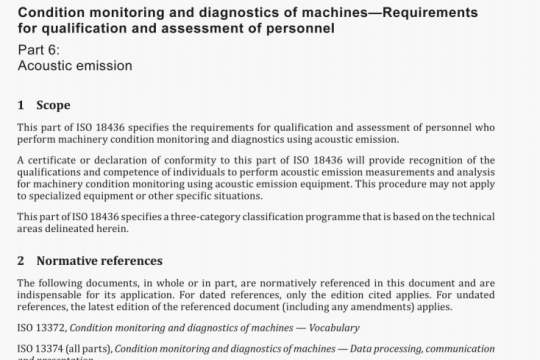ISO 48-4:2018 pdf free
ISO 48-4:2018 pdf free.Rubber, vulcanized or thermoplastic – Determination of hardness
The repeatability, or local domain precision, for each of the hardness test methods was established for each material as the values found in Table A.2. Two individual test results (obtained by the proper use of this document) that differ by more than the tabulated values of r (in measurement units) and (r) (in percent) should be considered as suspect, i.e. as having come from different populations, and should suggest that some appropriate investigative action be taken.
The reproducibility, or global domain precision, for the type AM durometer hardness test method was established for each material as the values found in Table A.2. Two individual test results obtained in different laboratories (by the proper use of this document) that differ by more than the tabulated values of R (in measurement units) and (R) (in percent) should be considered as suspect, i.e. as having come from different populations, and should suggest that some appropriate investigative action be taken.
A type 1 precision was evaluated (for both tests) using cured test pieces prepared from four different rubber compounds, A, B, C and D (with a range of hardness values), supplied to each of the six laboratories participating in the ITP. On each of two test days, two weeks apart, the following test sequence was carried out. Three test pieces were furnished for each compound, and the median value of five hardness measurements on each of the three test pieces was obtained for each of two operators. Fon each operator, the median value was selected for all three test pieces. The two median values were then averaged to obtain a single value designated as the test result for that test day. Shore AM measurements were made on one side of the test piece and IRHD measurements were made on the reverse side. The precision analysis was based on test result data, i.e. two test result values per laboratory.
The ISO/TR 9272:2005 option 2 outier treatment procedure, outlier replacement, was adopted since the ITP had the minimum number of six participating laboratories. This option 2 procedure replaces each outlier declared as significant with a value that is consistent with the data value distribution for the non-outlier data for that material. See ISO/TR 9272:2005 for the rationale behind this concept and for other details.
The precision results as determined by this ITP may not be applied to acceptance or rejection testing for any group of materials or products without documentation that the results of this precision evaluation actually apply to the materials or products tested.
The precision results for type AM durometer measurements are given in Table A.2, with the materials listed in order of increasing hardness. The results are given in terms of both absolute precision, r and R, and relative precision (r) and (R). General statements for the use of the precision results are given above.ISO 48-4 pdf download.




